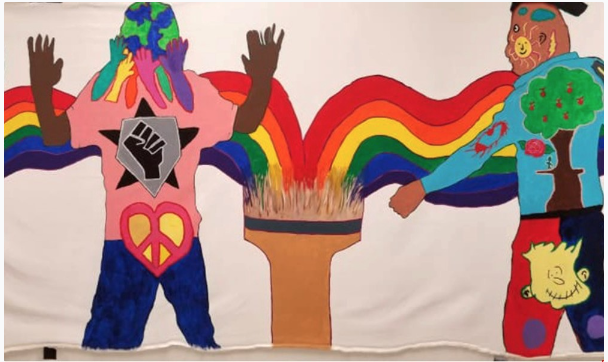
Artist Talk: Claudia Bernardi
Wednesday, April 12, 2023, 11:40am - 12:10 pm est
Peeler Art Center, University Gallery (lower level)
In a fresco, the pigments are not painted on the wall they are embedded in plaster in such a way that the pigments become the wall. In my work, I depart from the same principle: the pigments become the paper. I use pure pigments that are embedded in the paper by the pressure of a printing press. No binder, oil or medium is used in this process allowing the pigments to maintain their purest intensity. Each fresco on paper is the result of multiple runs through a printing press where layers of pure powdered pigments are pressed into wet paper. The coloration, often times, is a process of subtraction, a scraping away from the layers, a patient uncovering of colors reacting among themselves alchemically.
For the last thirty years, I have collaborated with the Argentine Forensic Anthropology Team in investigations of violations of Human Rights. The task of the AFAT is to perform exhumations of mass graves investigating crimes against civilian population. I participated in exhumations in El Salvador, Guatemala, Argentina, and Ethiopia. My artwork is profoundly influenced by these experiences. Not only in the narrative aspect of the piece but, most importantly, in the conceptual realm of finding images through the searching of layers of colored dust. I scratch the surface of the piece identifying human figures that interact with the world of the hidden images. The pigments convey the essential material prima. The intensity and the fugitive condition of pigments, so fragile yet persistent, are metaphors of the elusiveness of life and the never-ending determination of hope.
The installations are frequently created upon testimonies recovered during the exhumations. I conceptualize each installation as a documentary, departing from the reports presented by the Argentine Forensic Anthropology Team to the Supreme Court of the country where the investigation takes place. The reports narrate, chronologically, the findings of human remains and associated objects constructing a historical account of the massacre. The creation of artifacts and associated objects resembling the actual findings convey my visual response to the violence that I had witnessed. My intention goes beyond political criticism. It is a way of retaining the communal memories of the survivors.
The limited-edition of 12 books entitled “Palabras de Arena/ Words of Sand” was inspired by the stories I heard, and what I saw in Ciudad Juarez, Mexico.
In 2013, the International Committee of the Red Cross invited me to conduct and facilitate a collaborative and community-based project with youth affected by the effects of violence. Many of the participants were sons and daughters of the disappeared women in Juarez. The poems and the artworks meet upon the line that divides the vastness of the desert, ample with secrets that no one dares to address, the many layers of truth that can only be whispered, the presence of the missing women in their absence.
The desert becomes an open wound that holds the lives and deaths of the countless Mujeres de Juarez.
-Claudia Bernardi